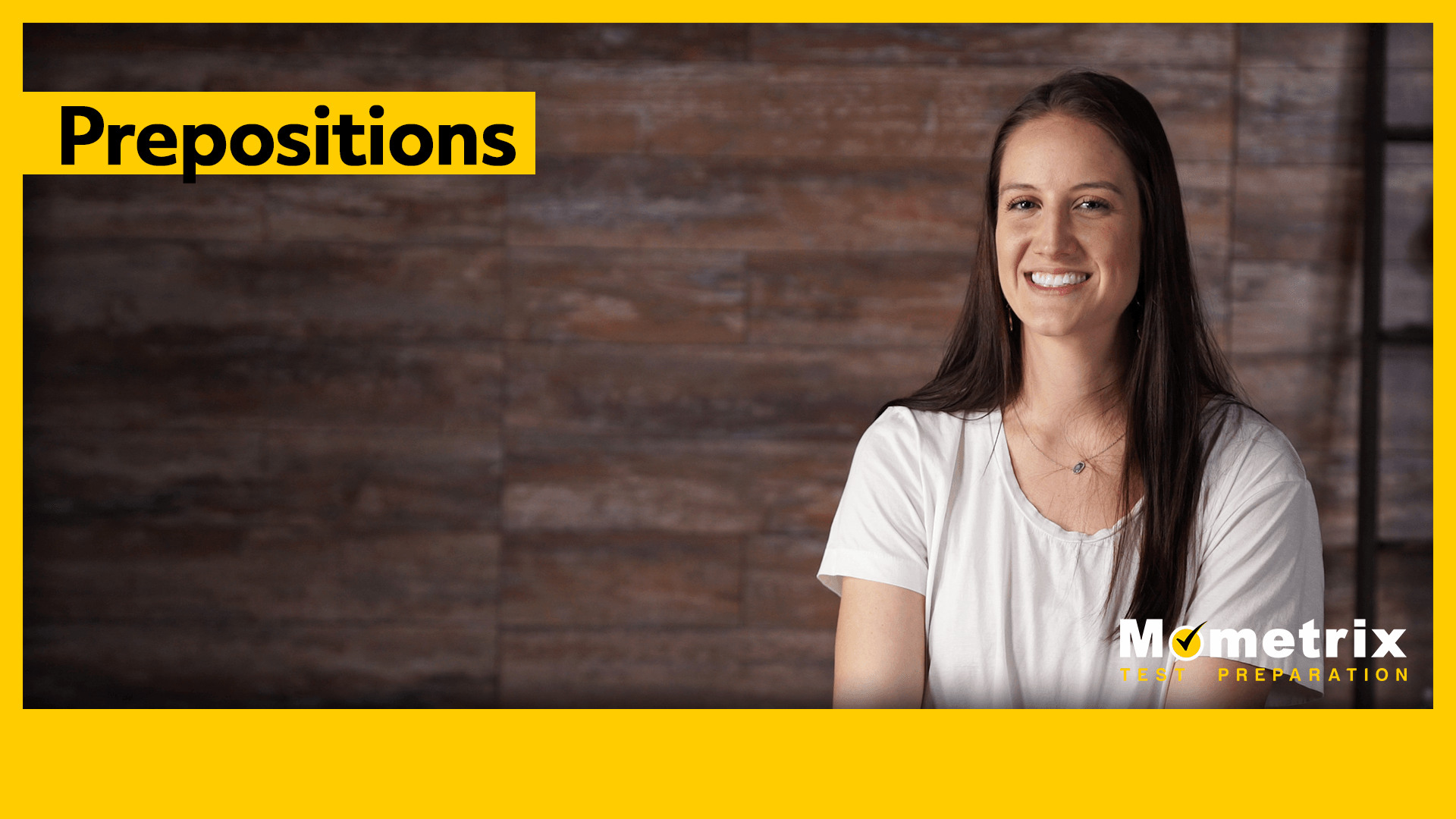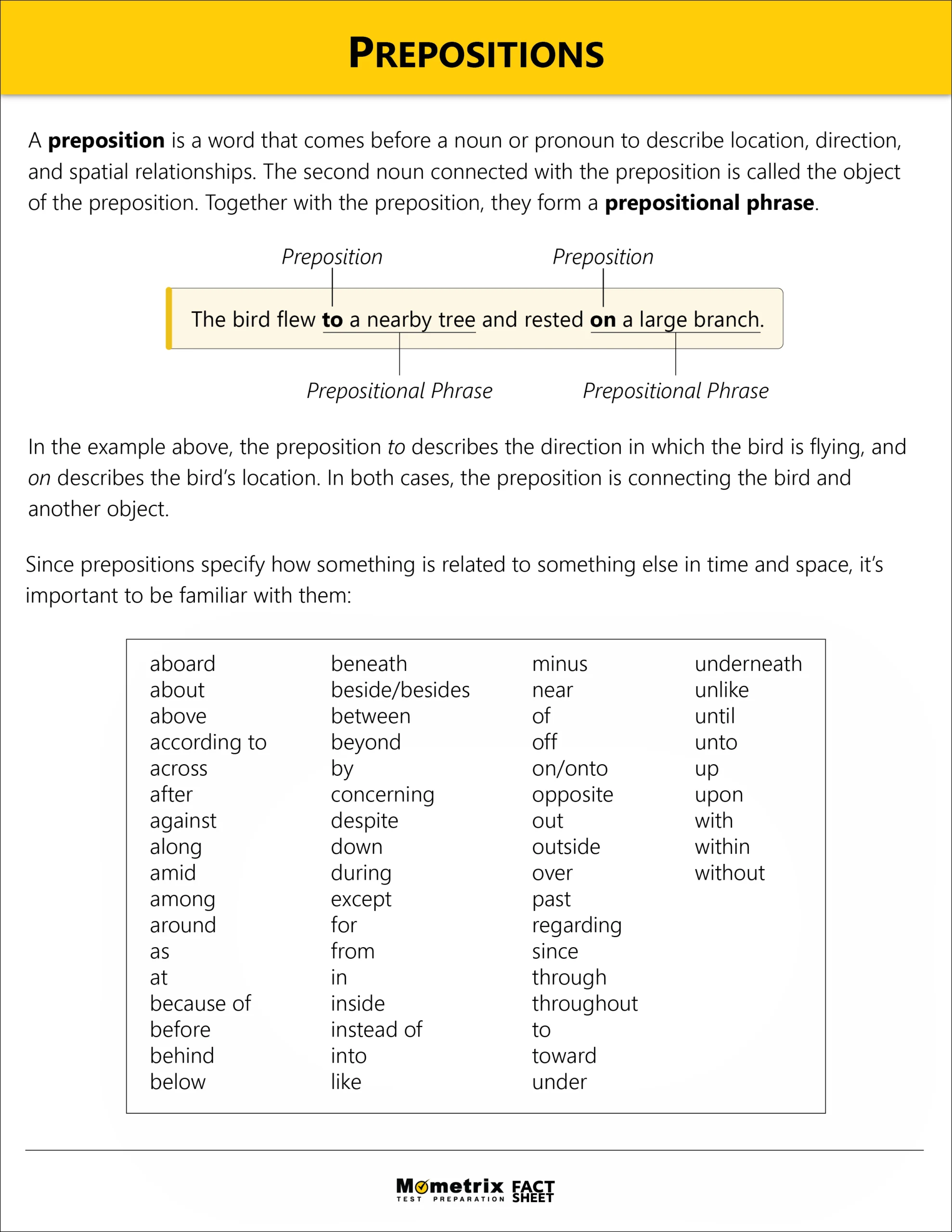
Prepositions are words that specify how something is related to something else in time and space. They work in a sentence to connect nouns and pronouns with other words and elements.
What is a Preposition?
Let’s start with this example:
There are two nouns in this sentence: dog and lake. We know from the verb swam what the dog is doing, but we need the preposition in to tell us where the swimming is happening. The dog is swimming in something, and that something is the lake.
Prepositional Phrase
The second noun connected with the preposition, in this case, the word lake, is called the object of the preposition. Together with the preposition, they form a prepositional phrase. There is no subject in the phrase “in the lake,” only a noun. Because of the preposition in, we know it’s a prepositional phrase.
Object of the Preposition
The is an article, not a noun, so we know it can’t be the object of the preposition. Lake, the noun we were trying to connect with our first noun dog, is the object of the preposition.
Most of the time, though not always, the object of the preposition comes after the preposition in the prepositional phrase.
When you’re trying to find the prepositional phrase in a sentence, first try to spot the preposition.
Finding Prepositional Phrases
Prepositions show direction, location, or time. Many of the most common prepositions are small words you use every day. At, by, for, from, in, of, on, to, and with are all prepositions.
Example #1
Think about this sentence and try to pick out the prepositional phrases.
There are three prepositional phrases in this sentence. Let’s start with a simple one. Joe, the proper noun, is connected to the noun store by the preposition to. It answers a directional question. Where did Joe go? He went to the store. The word store is the object of the prepositional phrase “to the store.”
Let’s look for another preposition in the sentence. You might have noticed our preposition in appeared again in this sentence. In isn’t a directional preposition like to, but it tells us where Joe was during his drive. He was in his car. Car is the object of the preposition in, and “in his car” is the prepositional phrase.
Now let’s look back to the first word in the sentence, after. This is also a preposition. Remember, prepositions show direction, location, or time. “After dinner” is a prepositional phrase that tells us when Joe went to the store. Dinner is the object of the preposition.
Example #2
Not all prepositional phrases are quite so simple. Think of it like a sandwich: You have to have bread and filling to make a sandwich, right? A sandwich can be as simple as cheese between two slices of bread, but it can also have meat, veggies, and spreads.
We can jazz up prepositional phrases the same way, with adjectives and adverbs. As long as you still have the “bread and filling” (preposition and object of the preposition), you’ll still have a prepositional phrase.
Take this sentence, for example:
“Over the trees” and “near the lake” are the two prepositional phrases in this sentence. Over is a preposition that tells us the direction the swallows flew, and near is a preposition that tells us where the trees were located. These prepositional phrases are fairly simple, but look what happens if we make the sandwich more interesting.
We still have the same two prepositions and prepositional phrases, but the words dark, town’s, and renowned are all adjectives. Dark is modifying, or adding meaning to, the object of the first prepositional phrase, trees, but it is otherwise not changing the preposition in any way.
The same is true of town’s and renowned. They are modifying the object of the preposition, lake. In this second phrase, near is still the preposition, and lake is still the object of the preposition.
Review
A preposition is a word that answers the question “When” or “Where” something happened in a sentence. It connects nouns or pronouns to other nouns in the sentence.
Preposition Examples
About, to, with, up, down, under, inside, after, before, and for are a few examples of common prepositions.
| Prepositions | ||
| aboard | beyond | out |
| about | by | outside |
| above | concerning | over |
| according to | despite | past |
| across | down | regarding |
| after | during | since |
| against | except | through |
| along | for | throughout |
| amid | from | to |
| among | in | toward |
| around | inside | under |
| as | instead of | underneath |
| at | into | unlike |
| because of | like | until |
| before | minus | unto |
| behind | near | up |
| below | of | upon |
| beneath | off | with |
| beside/besides | on/onto | within |
| between | opposite | without |
| Prepositions | ||
| aboard | beyond | out |
| about | by | outside |
| above | concerning | over |
| according to | despite | past |
| across | down | regarding |
| after | during | since |
| against | except | through |
| along | for | throughout |
| amid | from | to |
| among | in | toward |
| around | inside | under |
| as | instead of | underneath |
| at | into | unlike |
| because of | like | until |
| before | minus | unto |
| behind | near | up |
| below | of | upon |
| beneath | off | with |
| beside/besides | on/onto | within |
| between | opposite | without |
The object of the preposition is the noun that the preposition is talking about, and together with the preposition, those objects make prepositional phrases.
I hope that this was helpful for you!
Frequently Asked Questions
Q
What is a preposition?
A
A preposition is a word that tells you where or when something is in relation to something else. Common prepositions are in, of, on, with, at, by, and for. In the sentence below, the preposition on describes where the butterfly is in relation to the flower:
“The butterfly landed on the flower.”
Q
What is a prepositional phrase?
A
A prepositional phrase is a word group that consists of a preposition, the object of the preposition, and any words that affect the object. Most often, prepositional phrases modify nouns and or verbs. Here are a few prepositional phrase examples with the phrase underlined:
"Please stand beside your brother."
"The plane soared high above the clouds."
"The pencils are in the smaller box."
Q
What is the object of a preposition?
A
The object of a preposition is the noun or pronoun within a prepositional phrase. Most often, it is the noun or pronoun to the right of the preposition. Here are a few examples with the prepositional phrase underlined and object of the preposition bolded:
"The deer darted through the field."
"A crowd gathered outside the store."
"Eli sprinted from his car to the house."
Q
Can you end a sentence with a preposition?
A
Yes, it is acceptable to end a sentence with a preposition in casual, informal writing. In formal, professional writing, it is best to avoid ending a sentence with a preposition.
Q
Is "after" a preposition?
A
Yes, the word after is a preposition Here’s an example:
"I’ll finish my homework after dinner."
Q
Is "during" a preposition?
A
Yes, the word during is a preposition. Here’s an example:
"Your phone must be on silent during the movie."


